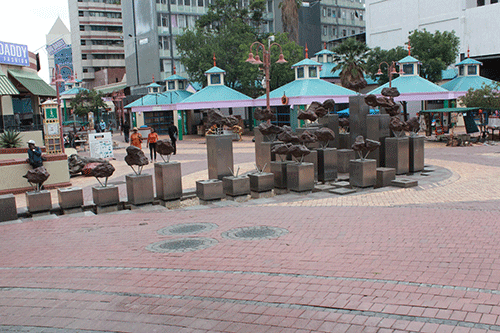Many tourists and locals alike are often seen taking pictures or having their pictures taken with the meteorites along Post Street Mall in Windhoek.
But very little is known about these solid pieces of debris that fell from the sky in prehistoric times, and were found in the village of Gibeon in the Hardap Region of Namibia around 1836.
Over 150 meteorites have been tracked and recovered, although some of the more valuable specimens have been stolen or smuggled out of the country, or donated to various research institutions around the world. In 1950, 30 of these prehistoric extra-terrestrial wonders were declared national monuments, as stated by the African Heritage blog.
Folklore has it that the meteorites were discovered by the Nama people, and used by them to make tools and weapons. Now named after the place where they were first discovered, some of the Gibeon Meteorites were mounted head-high on pedestals in Post Street Mall in 1995.
“They form part of a shower of meteorites that fell in the vicinity of Gibeon, hence the name Gibeon Meteorites,” tourism section head at the City of Windhoek Grace Pujatura told New Era.
Each piece weighs between 195kg and 506 kg.
“The city (municipality) does not maintain the meteorites; we only do daily audits. They are neither polished nor washed, as they remain in their natural state/setting. Hence, there is no specific cost attached to keeping them intact,” she stated.
Namibia has several declared national monuments in the geology sector, including the Hoba Meteorites near Grootfontein and the Mukorob (Finger of God) rock in Keetmanshoop, which later collapsed.
Pujatura said they are of geological and astronomical value, and that is why they were placed in a strategic location in the CBD to be accessible to both residents and tourists alike.
The Gibeon Meteorites are composed of an iron–nickel alloy containing significant amounts of cobalt and phosphorus. The crystal structure of this meteorite provides a classic example of fine octahedrite and the Widmanstätten pattern, which is appreciated for its beauty by both collectors and designers of jewellery.
She noted that some scoundrels tried to purloin the monuments in December 2018.
“There was a failed attempt to remove one meteorite. Fortunately, because of its weight, it could not be carried away, and it fell from the stand. It was found and taken for safekeeping. It is equally evident when viewing the meteorites in their current settings that there were unsuccessful attempts to saw off pieces,” shared Pujatura.
Nokokure Karamata, an educator and a fan of the monuments, told New Era that she loves looking at them when she is in the city centre.
“They are presented openly, and everyone can have access to them and take pictures around them. They are simply beautiful to look at. I have shown old pictures I took with the meteorites to my daughter, who also had hers taken there as well,” she explained while running errands in town.
Karamata said the rocks are not commercialised, which makes them easily accessible, and that she is impressed with the way they have been maintained all these years.
She urged Namibians to appreciate art, and that such pieces form part of tourist attractions as they have worthy stories behind them.
So, when visiting Windhoek, make sure to make a turn at these prehistoric wonders that are truly mesmerising.


